Food Prices in Paraguay: A Local Expat’s Guide
Introduction
Living in Paraguay certainly provides a blend of the lifestyle I love: simplicity, a warm climate, and affordability—a combination that has won over expats just like me, who’ve traded the hustle of bigger cities for Asunción’s laid-back charm.
One of the biggest surprises for newcomers to Asunción, is the cost of food prices in Paraguay. But it’s not just about prices… food prices in Asunción reflect Paraguay’s rich agricultural roots, community-centered culture, and evolving economy.
In this guide, I’ll take you through the ins and outs of grocery shopping, dining out, and understanding food inflation in Paraguay, so you can fully appreciate both the savings and the flavors of this hidden gem.
Be sure to watch the YouTube videos linked below, as I also do various walks through the supermarket when I buy groceries here in Paraguay, along with what a day in my life looks like living in Paraguay.
The Cost of Food in Paraguay
Food prices in Paraguay is one of the many reasons expats find it such an attractive place to settle. While there are certainly opportunities to splurge on imported goods or high-end dining, the everyday staples are still quite affordable, especially if you stick to locally produced items.
And just a heads up, Paraguay is one of my favourite countries to eat local in. They have an abundance of fresh local produce and meats that come from the interior of the country, meaning you have always have access to delicious local foods in the supermarket.
However, if you love your fish and seafood, this is not the destination for you!
The Staple Foods That Define Paraguay
Paraguayan cuisine is rooted in fresh, simple ingredients that are both abundant and affordable.
Staples like mandioca (cassava), maize, and beef (it’s delicious here in Paraguay) are not just dietary essentials—they’re part of the national identity.
For example, you can pick up a kilo of mandioca at a market for less than the cost of a coffee in Europe, and it’s a key side dish for almost every meal. Fresh fruits and vegetables—think papayas, bananas, and leafy greens—are not only cheap but also incredibly flavorful thanks to Paraguay’s fertile land.
One standout item is beef, which is both high-quality and affordable. Paraguay is a major beef exporter, and that means locals benefit from tender cuts at prices that would make a steakhouse chef jealous. Whether you’re firing up an asado (barbecue) or just grabbing ground beef for tacos, meat is a highlight of shopping in Paraguay.
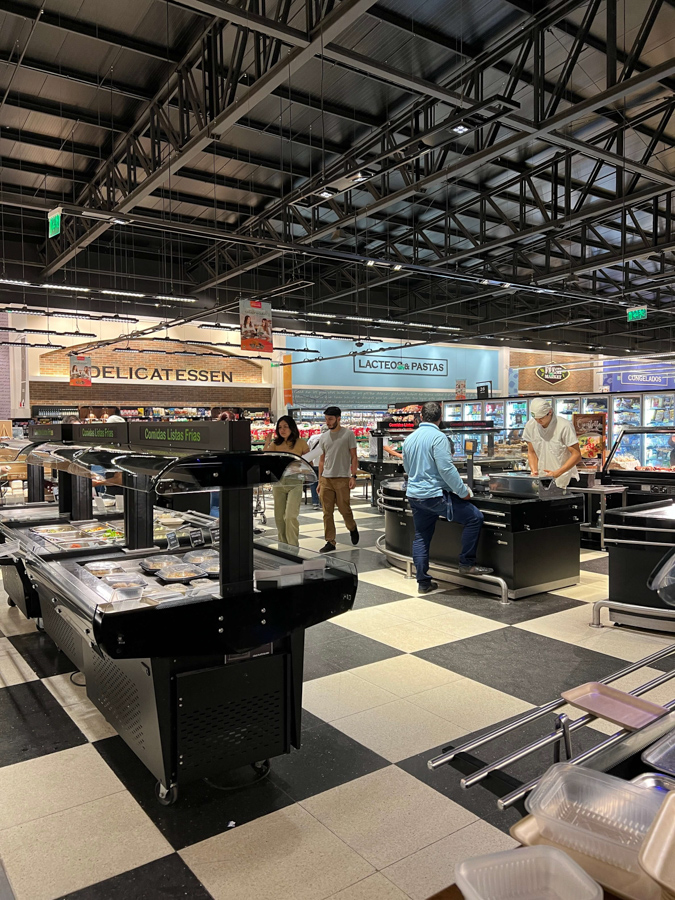
Comparing Costs to Other Countries
For someone who’s also lived in places like Argentina or Brazil, the food prices in Paraguay are quite a bit more affordable than most other countries in Latin America. I will say that I found both Colombia and Peru to be more affordable overall than Paraguay when it comes to meals and supermarket prices, but not by a large amount.
According to data from Expatistan, groceries in Asunción can cost significantly less than in Buenos Aires or São Paulo, especially when it comes to essentials like produce and meat.
This affordability extends to dining out too—something I’ll dive into later—but it’s not just about savings. It’s about value: the quality of the food you get for the price is exceptional here in Paraguay.
Why Food is Affordable in Paraguay
Paraguay’s economy is heavily agricultural, and that has a direct impact on food prices. The country’s self-sufficiency in producing staples like grains, beef, and dairy keeps costs low, especially in local markets.
Not only this, but the communal way of living—think neighbors sharing homegrown produce or hosting potlucks between friends—means food is more than just sustenance; it’s a way to connect without breaking the bank.
Food prices in Paraguay reflect not only its affordability but also its culture. Living here has taught me to appreciate the simplicity and abundance of fresh, local ingredients. Whether you’re shopping for mandioca at the market or indulging in a juicy steak, Paraguay has the best of both worlds for locals and expat alike – delicious food that you can count on as healthy.
Grocery Shopping and Supermarkets in Paraguay
Shopping for groceries in Paraguay is honestly quite simple and straightforward, but of course, this depends on where you shop. Whether you prefer bustling outdoor markets or sleek supermarkets, there’s something for everyone in Paraguay—and for every budget.
🌎 Ready to Go Global?
Explore smart strategies for residency, banking, and diversification in Latin America and beyond:
- ✅ Book a Strategy Consult – Get personalized guidance tailored to your global lifestyle.
- 🇵🇾 Paraguay Residency Essentials Program – Fast-track your second residency with low taxes and no minimum stay.
- 🇺🇾 Uruguay Residency Essentials Program – Discover this stable, scenic option for long-term relocation.
- 💳 U.S. Banking for Non-Residents – Open U.S. accounts and access credit even if you don’t live in the States.
🌐 For sovereign individuals and digital nomads building a borderless life.
Supermarkets
Supermarkets in Paraguay, like Superseis, Stock, and Biggie, offer a large variety of local and international products. These stores are convenient, well-organized, and air-conditioned—perfect for the hot Paraguayan summers.
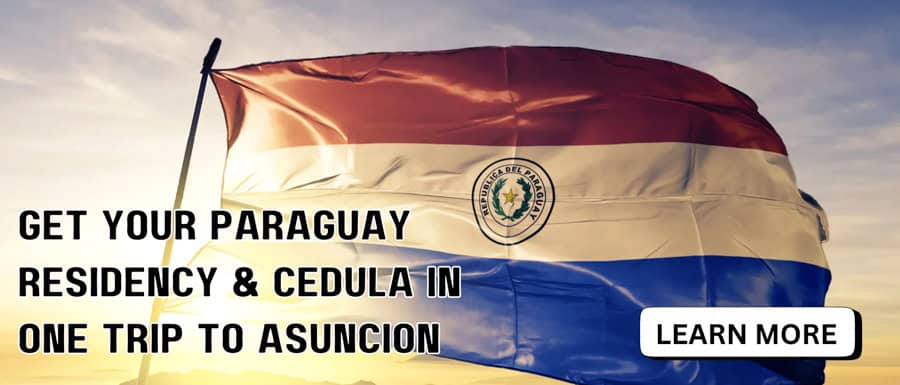
I personally like Superseis the most, as this supermarket has the most variety and they are always the largest. Ironically, Biggie is the smallest supermarket you will find in Paraguay, but there is a Biggie on almost every other street corner.
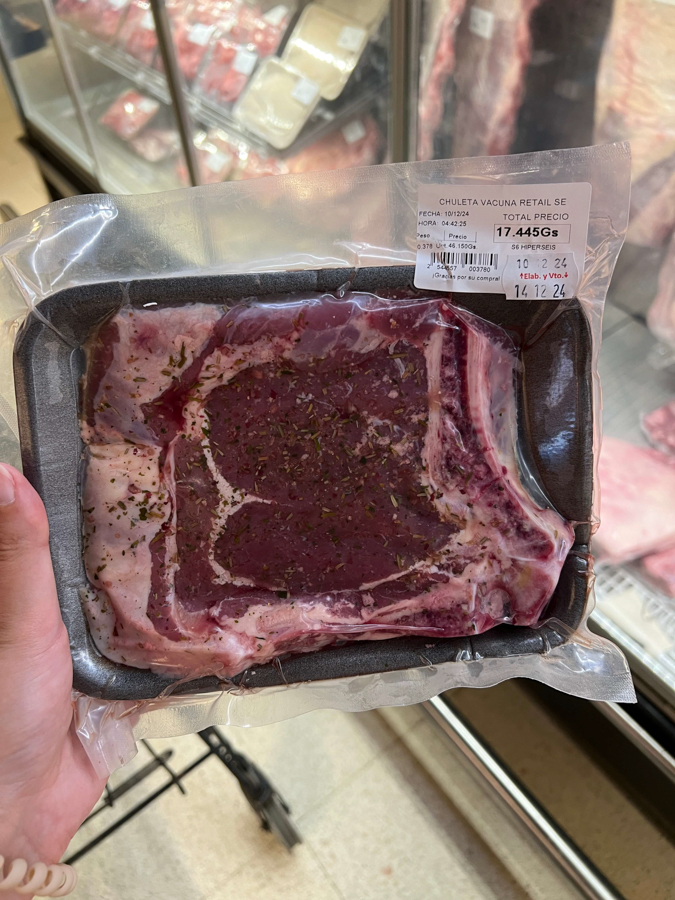
Still, staples like rice, pasta, and cooking oil are affordable at all the supermarkets in Paraguay. Many supermarkets also run regular promotions, making it easy to snag deals on pantry essentials or bulk items.
I do want to include that you will often see at many of the supermarkets, especially in Superseis, that if you pay with a local bank card, you get a large percentage off your grocery shop. Using local cards like Ueno, Sudameris, Atlas, Rio, and others, can provide a local discount, however I have not found these deals to be true when I have tried to use them.
International products in Paraguay are, of course, more expensive, and Superseis has one of the largest international aisles in the country. This is by no means a large international section, however it does include basic international food options such as a pickles and pasta sauces from abroad. These products are, of course, more costly.
There is also another supermarket you may see, called Fortis. This is a large, stock supermarket, similar to Costco. You wont see as many Fortis stores around, but there are few in Asuncion, and one in Ciudad del Este.
Of course we have to mention the famous Casa Rica, which currently has three locations in Asuncion. This is a popular store among expats and foreigners, and includes a large selection of imported products, many from Germany and the US.
They also have delicious baked goods and cakes available for purchase each day, along with a restaurant and deli food to go.
Food Prices in Paraguay at Local Markets
For a true taste of Paraguay, nothing beats the experience of shopping at the Mercado 4 in Asunción or similar small neighborhood markets.
In these local markets, you’ll find mountains of fresh fruits and vegetables, often harvested just hours before they’re sold. Bargaining is common, so don’t be afraid to negotiate for the best price, especially if you are buying a large quality.
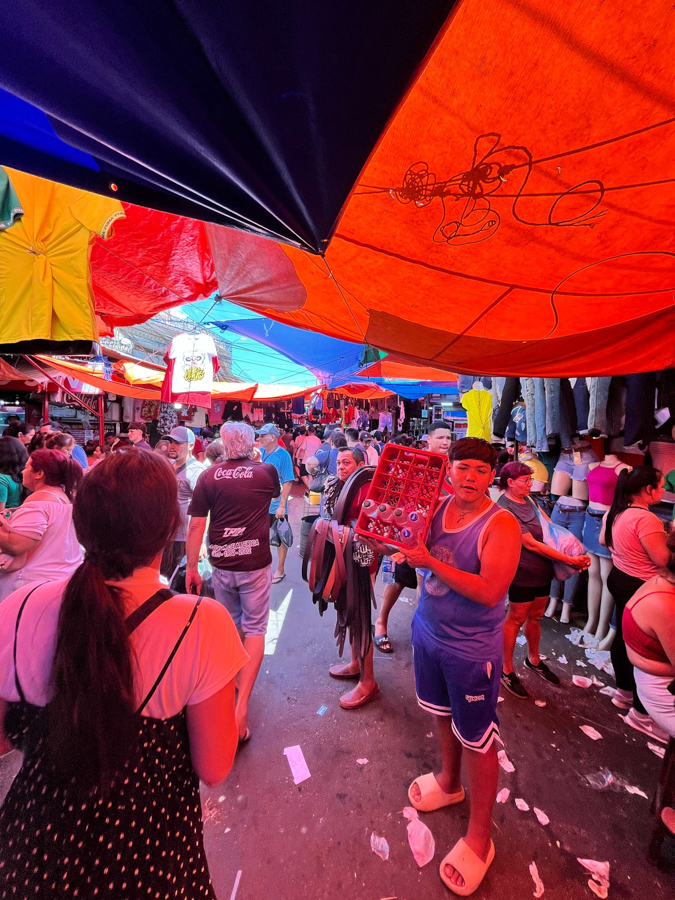
For meat lovers, the butcher stalls at local markets are a revelation. Cuts are fresh, prices are low, and the quality rivals what you’d find in high-end supermarkets abroad. A kilo of beef, for example, can cost as little as USD 4–5. Similarly, eggs and dairy products are incredibly affordable, and the vendors are always happy to share cooking tips or recipes.
Specialty Stores and Organic Options
As Paraguay’s expat community grows, so does the demand for specialty stores and organic options. Stores like Casa Rica cater to those looking for gluten-free, organic, or gourmet products. While these items come at a premium, they’re a great option for those with specific dietary needs or a craving for something unique.
Grocery shopping in Paraguay is more than just a chore—it’s a cultural experience. The blend of modern supermarkets and traditional markets ensures you can enjoy the best of both worlds, whether you’re looking for affordability, variety, or a deeper connection to the local way of life.
Food Prices in Paraguay and Dining Out in Paraguay
Dining out in Paraguay is an adventure for the senses. The country’s culinary scene combines traditional Paraguayan flavors with international influences, offering something for every palate and budget.
Traditional Paraguayan Cuisine
If you want to eat like a local, start with the traditional dishes. Paraguayan food is hearty and flavorful, with staples like sopa paraguaya (a cornbread-like dish), chipa (a cheesy bread), and milanesa (breaded meat cutlets). Restaurants specializing in Paraguayan cuisine, such as Lido Bar in downtown Asunción, are perfect for an authentic experience. Meals here are incredibly affordable—a filling plate of puchero (beef stew) with a side of mandioca might cost as little as USD 5.
Another must-try is the asado, Paraguay’s take on barbecue. Many restaurants, as well as casual outdoor eateries, serve perfectly grilled beef, pork, and sausages. It’s not just a meal—it’s a social event, and the smoky, succulent flavors are unforgettable.
International Dining Options
While traditional food is popular, Paraguay’s dining scene also caters to international tastes. In Asunción, you’ll find everything from Italian trattorias to sushi bars and even Middle Eastern eateries. Here are some of my favourite restaurants:
- Pulcinella La Vera Napoletana – Italy Food
- La Queseria – Great work lunch spot
- Karu Las Mercedes – Cute café
- Casa Clari – The best views of Palacio de Lopez and amazing food, downtown Asuncion near Catedral
- La Vermuteria – Also near Catedral, cute European vibes restaurant
- Kaiseki Sushi Bar – Upscale sushi bar
- El Café de Aca – Three locations in Asuncion, the best café, usually busy and many foreigners
For those craving a burger or pizza, there are plenty of options, with prices typically lower than in North America or Europe. A high-quality pizza at a mid-range restaurant might set you back around USD 10–12, while a gourmet burger with fries and a drink could cost USD 8–10.
While there are a few McDonalds scattered throughout the city, you will find the most Burger Kings (Paraguayans LOVE Burger King), and along with some KFC locations. Paraguayans are also huge fans of Pizza Hut – expect to see many!
You can also use the app PedidosYa, and the newer app, Monchis, as the delivery food apps in Paraguay. You will find these apps work in the major cities, but the restaurant selection varies depending on your location in each city.
🌎 Ready to Go Global?
Explore smart strategies for residency, banking, and diversification in Latin America and beyond:
- ✅ Book a Strategy Consult – Get personalized guidance tailored to your global lifestyle.
- 🇵🇾 Paraguay Residency Essentials Program – Fast-track your second residency with low taxes and no minimum stay.
- 🇺🇾 Uruguay Residency Essentials Program – Discover this stable, scenic option for long-term relocation.
- 💳 U.S. Banking for Non-Residents – Open U.S. accounts and access credit even if you don’t live in the States.
🌐 For sovereign individuals and digital nomads building a borderless life.
Cafes and Casual Dining
Paraguay’s cafe culture is vibrant, especially in Asunción. Cafes like El Café de Acá and Café Consulado are popular spots for brunch or a casual meet-up.
They serve up delicious coffee, pastries, and light meals in relaxed, stylish settings. A cappuccino paired with a slice of homemade cake will cost you around USD 4–6, making it an affordable luxury.
For a quick and casual bite, food courts in malls and food trucks around the city offer a range of options. Here, you can grab anything from a classic lomito sandwich to empanadas or even Paraguayan-style hot dogs, all for under 5 or 6 dollars.
Dining Out: The Experience
One of the best parts of dining out in Paraguay is the warm, welcoming atmosphere. Whether you’re in a fancy restaurant or a roadside diner, the service is usually friendly and unhurried, encouraging you to relax and enjoy your meal.
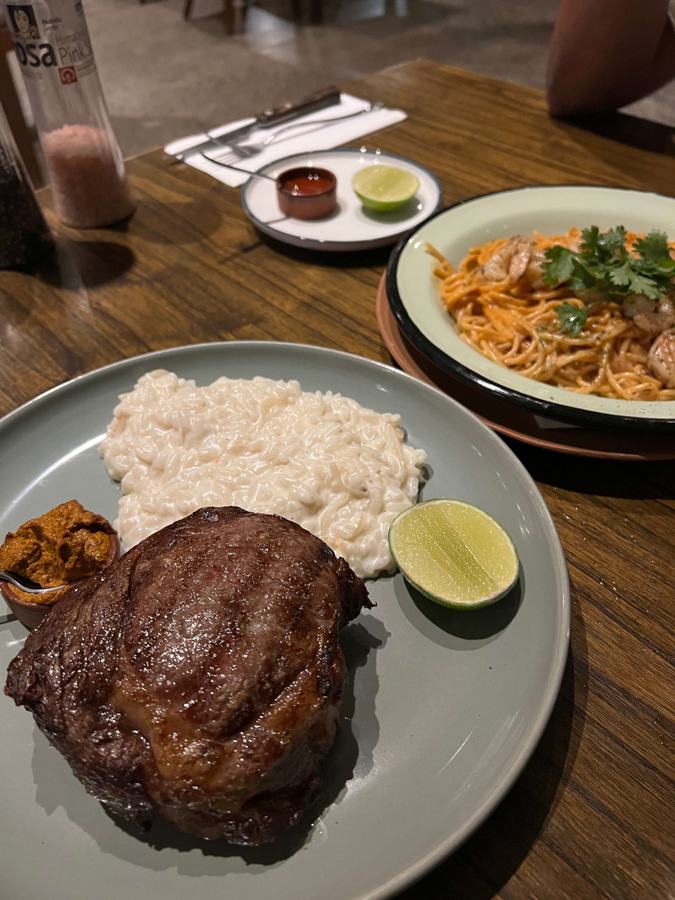
Dining out in Paraguay offers incredible value and variety. From traditional dishes to international cuisine, the country’s food scene reflects its diverse cultural influences, making every meal an opportunity to explore something new.
We recently visited an upscale restaurant in the Villa Aurelia area called Cocina Clandestina, which offered amazing food (we had steak and pad thai) and a beautiful location and ambiance. This restaurant is considered upscale for Paraguay, but for one appetizer, two entrees, and two cocktails, and a 10% tip, we paid 420,000 GS (55 USD). Not bad if you ask me!
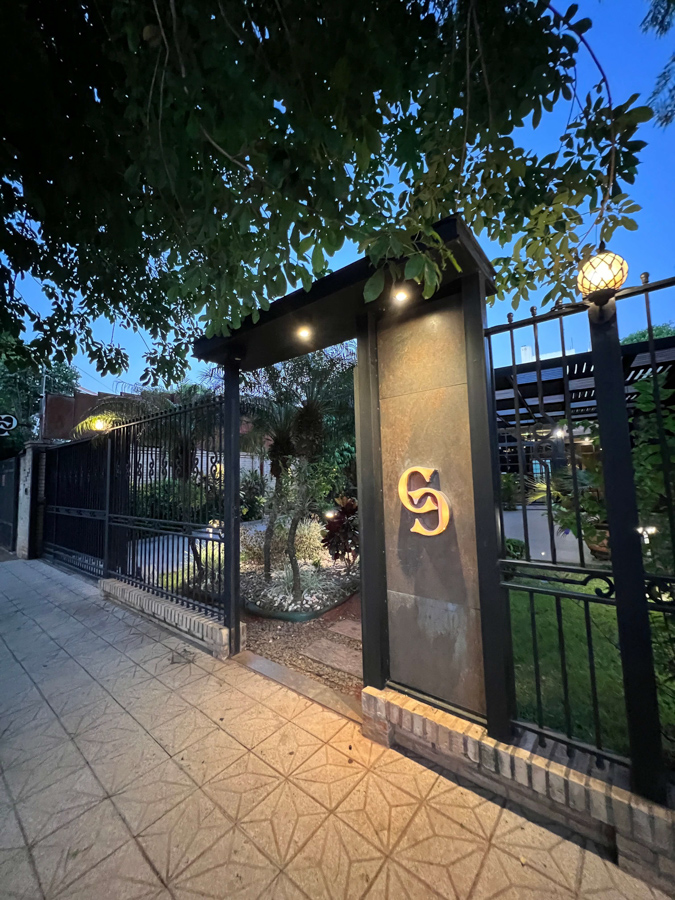
Food Prices in Rural vs. Urban Paraguay
Paraguay’s diverse geography and lifestyle create noticeable differences in food prices between urban and rural areas. Whether you’re shopping in the bustling markets of Asunción or the quaint corners of a rural town, each has its unique advantages.
Urban Cities: Variety at a Premium
In urban areas like Asunción, the abundance of supermarkets, specialty stores, and trendy cafes offers convenience and variety. You can find everything from local produce to imported goods, but the latter often comes with a steep markup. For example, a bottle of imported olive oil or a bag of quinoa in Asunción might cost two to three times more than their local alternatives.
Restaurants in urban areas cater to a broader audience, including expats and tourists, which can drive prices higher. Upscale eateries and international dining options in neighborhoods like Villa Morra or Carmelitas offer gourmet experiences at affordable prices by global standards but are still pricier than rural counterparts.
Rural Areas: Fresh and Affordable
In contrast to this, rural areas are a haven for fresh, affordable produce. Many small towns have weekly markets where farmers sell their harvests directly to the public. Here, you’ll find bananas, papayas, mandioca, and other staples for a fraction of the cost in the city. A large bag of fresh vegetables might only set you back USD 2–3, while free-range eggs or freshly butchered meat can be equally budget-friendly.
Dining out in rural Paraguay is also significantly cheaper. Local restaurants, often family-run, serve hearty portions of traditional dishes for as little as USD 3–5 per meal. While you won’t find much in the way of international cuisine, the authenticity and warmth of these establishments more than make up for the lack of variety.
Keep in mind if you are seeking a more modern life, the cities, especially Asuncion, will be for you. Not only do they, of course, have more dining and food options, but the rural areas of Paraguay are… well… rural.
Here, you will often find dirt roads and roadside restaurants. While this can fun and exciting for a few days, you will find most expats in the cities, especially living longer-term in Asuncion.
Seasonal and Local Variations in Food Prices
Paraguay’s agricultural roots and subtropical climate play a significant role in shaping food prices. Seasonal availability and regional specialties can impact what’s on offer and how much you’ll pay, adding a new element to grocery shopping and dining out.
Seasonal Produce: Eating with the Seasons
One of the joys of living in Paraguay is the abundance of fresh, seasonal produce. Fruits like mangos, watermelon, and pineapples flood the markets during their respective harvest seasons, often selling for as little as USD 0.50 per kilo, which you can readily find for sale on the roadsides. Similarly, vegetables like tomatoes, squash, and corn are much cheaper when in season.
However, out-of-season produce, particularly fruits, can see a significant price hike, especially in supermarkets that import them. For instance, buying strawberries in the middle of winter could cost twice as much as during their summer peak. Shopping at local markets and sticking to in-season items is the best way to keep costs low and enjoy the freshest flavors.
You will often find fruit and vegetables that are out of season, or even imported from abroad, are not fresh in the supermarkets. I find bananas are almost never green or yellow in the supermarkets, but are brown and old. You want to buy with the seasons, and local produce, if at all possible.
Regional Specialties: Local Flavors, Local Prices
Different regions in Paraguay have their own culinary specialties, often influenced by what grows or thrives locally. For example, in the Chaco region, beef and dairy products are plentiful and affordable, reflecting the area’s strong ranching tradition.
Beef is something you will find plentiful amounts of in Paraguay, and it is all delicious, well raised and cut beef. Most of the beef in Paraguay is exported, but the local supermarket beef is all local to Paraguay, and the prices in stores are wildly low for well-raised beef!
On the other hand, in the eastern regions near Ciudad del Este, you’ll find tropical fruits and freshly caught river fish at excellent prices. You will almost NEVER find fresh fish in Asuncion… trust me, I’ve tried. The best I have come across is freezer burnt supermarket fish.
When dining out, regional influences also come into play. Restaurants in beef-producing areas often serve better cuts of meat at lower prices than urban counterparts. Similarly, smaller towns near fishing communities may offer fresh surubí or dorado (fish) dishes that are both delicious and wallet-friendly.
Inflation and Price Stability
While Paraguay generally enjoys a stable economy, fluctuations in food inflation can affect prices, particularly for staples like flour, rice, and sugar. External factors like weather conditions or global market trends also influence costs. Staying informed and adapting to these changes by diversifying your shopping habits—such as alternating between supermarkets and local markets—can help you manage your budget effectively.
However if you have between 3-5K USD to live on in Asuncion, you will be able to happily shop at supermarkets such as Superseis and Casa Rica, have a high quality of food, and eat well, without breaking the bank.
Tips for Saving Money on Food in Paraguay
While food in Paraguay is generally affordable, adopting smart habits can stretch your budget even further and enhance your overall experience.
1. Shop Local Markets
Traditional markets like Mercado 4 in Asunción offer fresh produce, meat, and grains at prices significantly lower than supermarkets. Bring cash, as most vendors don’t accept cards at the local markets, and don’t be afraid to bargain for the best deals (if you speak Spanish).
If you aren’t buying in a local market, almost everywhere else in Paraguay accepts credit and debit cards… most cafes and restaurants even accept American Express with no issues.
2. Buy Seasonal Produce
Stick to fruits and vegetables that are in season. Not only are they fresher and tastier, but they’re also more affordable. Learn the harvest cycles of popular items like mangos, papayas, passion fruit, and mandioca to plan your shopping.
3. Cook at Home
Eating out can be inexpensive, but cooking at home saves even more. Paraguayan staples like rice, beans, and fresh produce can be turned into nutritious meals for just a few dollars. Plus, visiting local butchers or farmers allows you to buy fresh ingredients directly.
4. Explore Supermarket Alternatives
While supermarkets are convenient, smaller grocery stores and cooperatives often have better prices on staples like flour, sugar, and oil. You’ll also find more locally sourced products.
There are also many small local areas that become local markets simply from the locals selling food and goods.
5. Embrace Paraguayan Staples
Traditional Paraguayan dishes like sopa paraguaya, chipa, and mbeju rely on affordable local ingredients like cornmeal, cheese, and mandioca. Learning to make these dishes at home can be a fun and cost-effective way to enjoy Paraguayan culture.
6. Look for Lunch Deals
Restaurants and cafés often offer menú ejecutivo (executive menu) lunch deals, which include a main course, a drink, and sometimes dessert, all for one low price. These deals are especially common in urban areas and near commercial areas.
Conclusion: Why Food in Paraguay Is More Than Just a Cost
Living in Paraguay has given me a deep appreciation for the country’s culinary culture and the affordability of its food. Whether you’re savoring a hearty asado with friends, exploring the vibrant local markets, or indulging in fresh tropical fruits, Paraguay offers a unique combination of value and delicious flavor.
If you’re considering a move to Paraguay or just planning a visit, rest assured that food won’t just be a necessity—it will be one of the highlights of your experience in Paraguay.
If you are wanting more details on the full apartment rental process in Paraguay, and what the costs and details of renting in Paraguay are, check out this blog post.
Read More on Living in Paraguay: Food Prices in Paraguay: A Local Expat’s Guide- When is the best time visit Paraguay? Here’s your full guide for when to visit
- What is the Currency of Paraguay and What’s It Worth? Here’s the full breakdown
- Ready to Rent an Apartment in Paraguay? Here’s My Mistakes Of Apartment Renting
- Living in Paraguay? Is it really worth it?
- Full Guide to the Ins and Outs of Getting Residency in Paraguay
- My 16-Hour Sleeper Bus Experience from Brazil to Paraguay
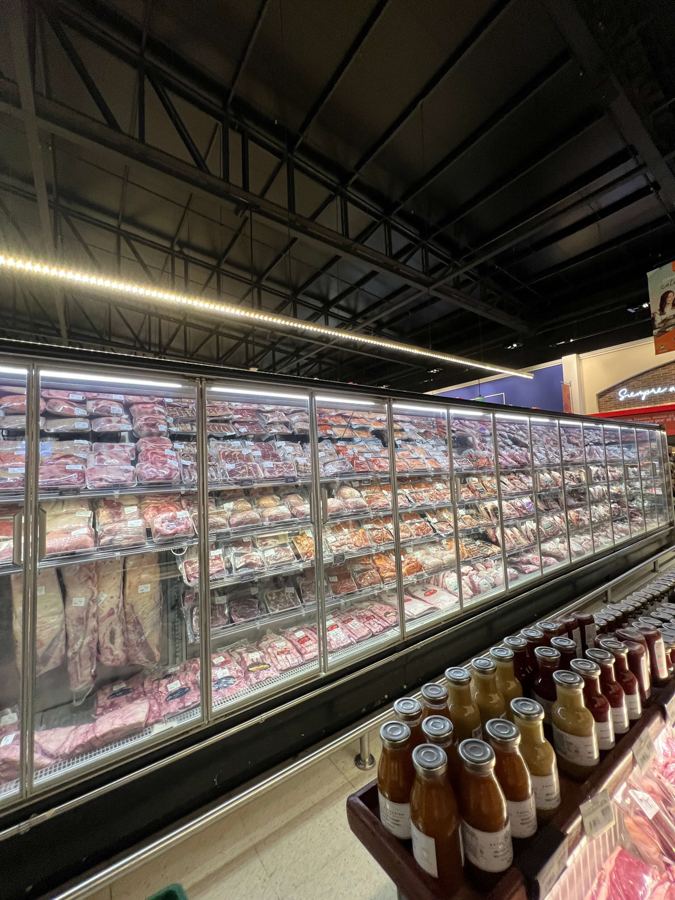
FAQ: Food Prices in Paraguay
In Paraguay, the cost of dining out depends on the type of restaurant. A casual meal at a local eatery (like lomiterías or family-run spots) can cost around USD 3–6, while mid-range restaurants may charge USD 10–20 per person.
Fine dining or international cuisine can go up to USD 30 or more per meal.
For a single person, monthly groceries can range from USD 100–200, depending on your shopping habits. Families may spend USD 300–500, particularly if they include imported items in their purchases, or are visiting the premium groceries stores as mentioned above.
Yes, imported goods are typically more expensive due to import taxes. Items like olive oil, specialty cheeses, and international snacks can cost two to three times their price in neighboring countries. Opt for local alternatives whenever possible to save money.
Local markets like Mercado 4 in Asunción or smaller town markets offer the freshest produce at the best prices. These markets often have a wide variety of fruits, vegetables, and herbs grown by local farmers.
Paraguay is known for its high-quality beef, and meat prices are relatively low compared to other countries. Expect to pay around USD 2–5 per kilo for fresh cuts of beef, chicken, or pork. Prices are even lower in rural areas.
Paraguayan cuisine is full of budget-friendly options. Try sopa paraguaya (cornbread), mbeju (starch pancake), chipa (cheese bread), or vori vori (traditional local soup with dumplings). These dishes are filling, delicious, and inexpensive to make at home or buy from local eateries.
Urban areas like Asunción have higher food prices due to greater demand and variety. In rural areas, locally produced items like fruits, vegetables, and meat are much cheaper. However, imported goods are rare and often pricier in rural locations.
Cooking at home is generally cheaper, especially if you buy ingredients from local markets. That said, eating out at local restaurants can also be very affordable, with hearty meals available for as little as USD 3–5.
While Paraguay has seen some food inflation, the impact has been moderate compared to global standards. Staples like rice, beans, and mandioca remain affordable, although imported items and certain packaged goods have seen noticeable price increases.
Urban areas offer some vegetarian and vegan-friendly restaurants, and local markets provide an abundance of fresh fruits and vegetables. However, traditional Paraguayan cuisine tends to be meat-heavy, so dining out will certainly require more scoping about than normal.

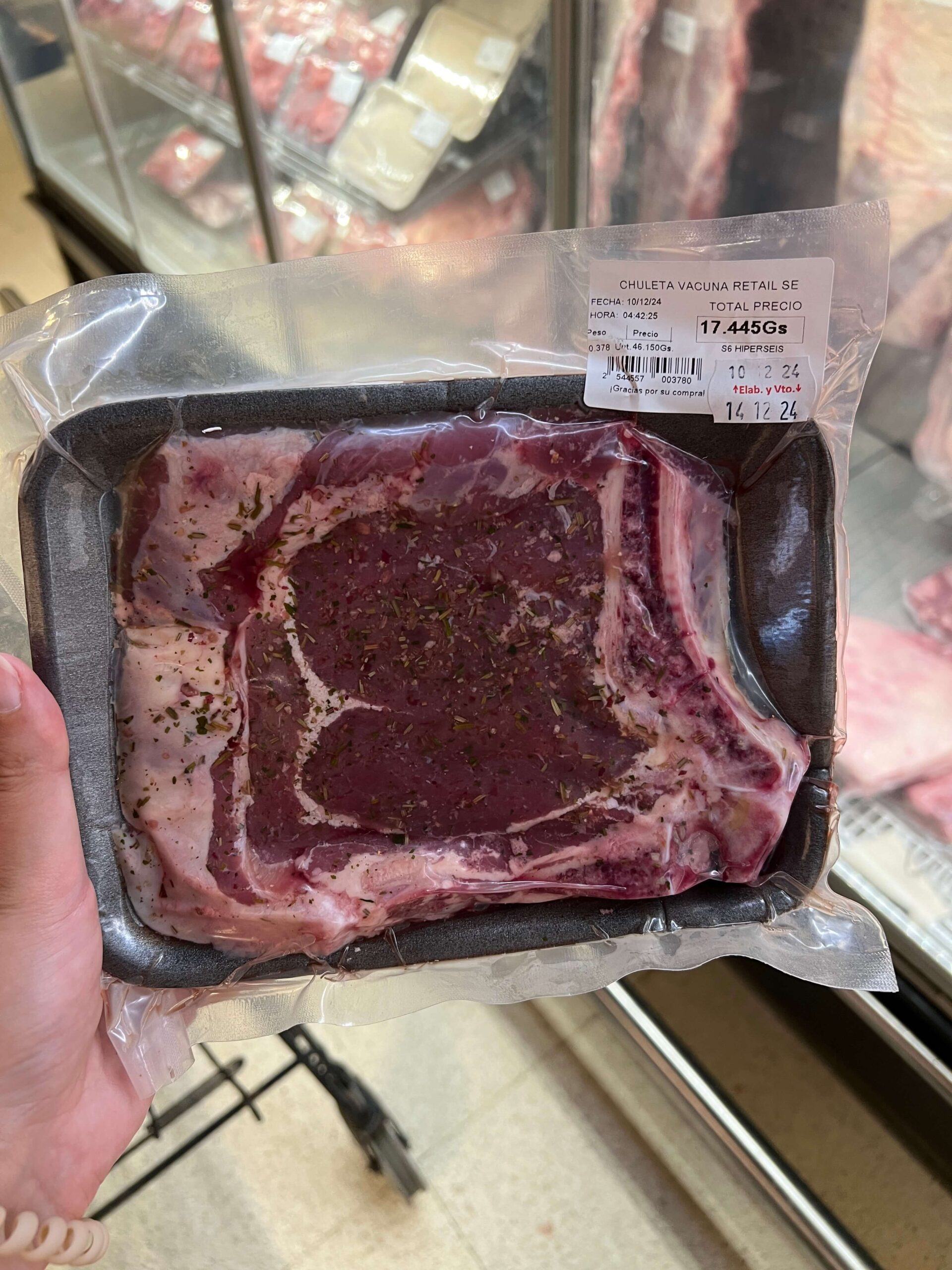
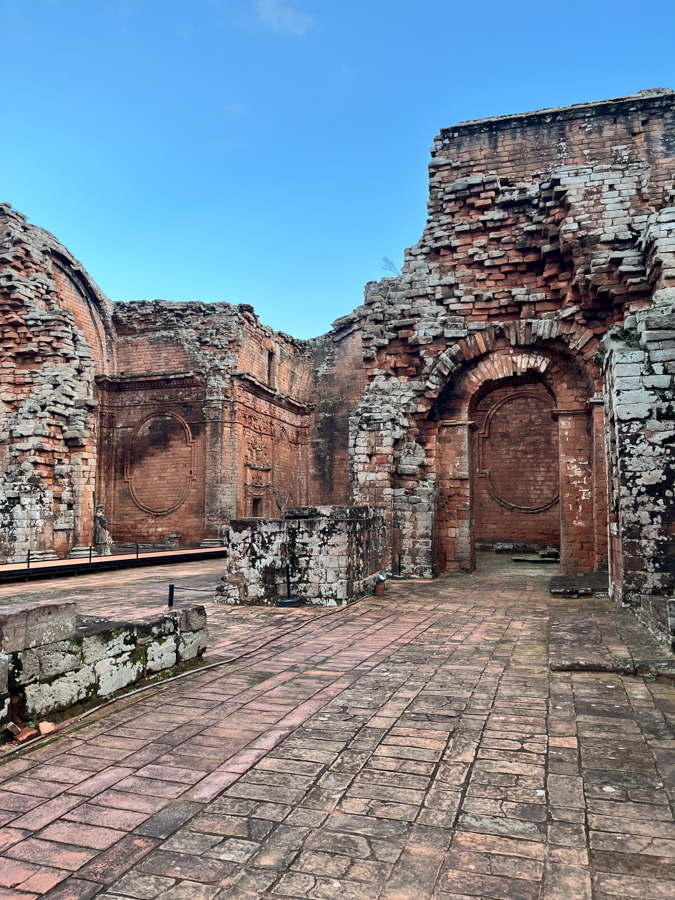
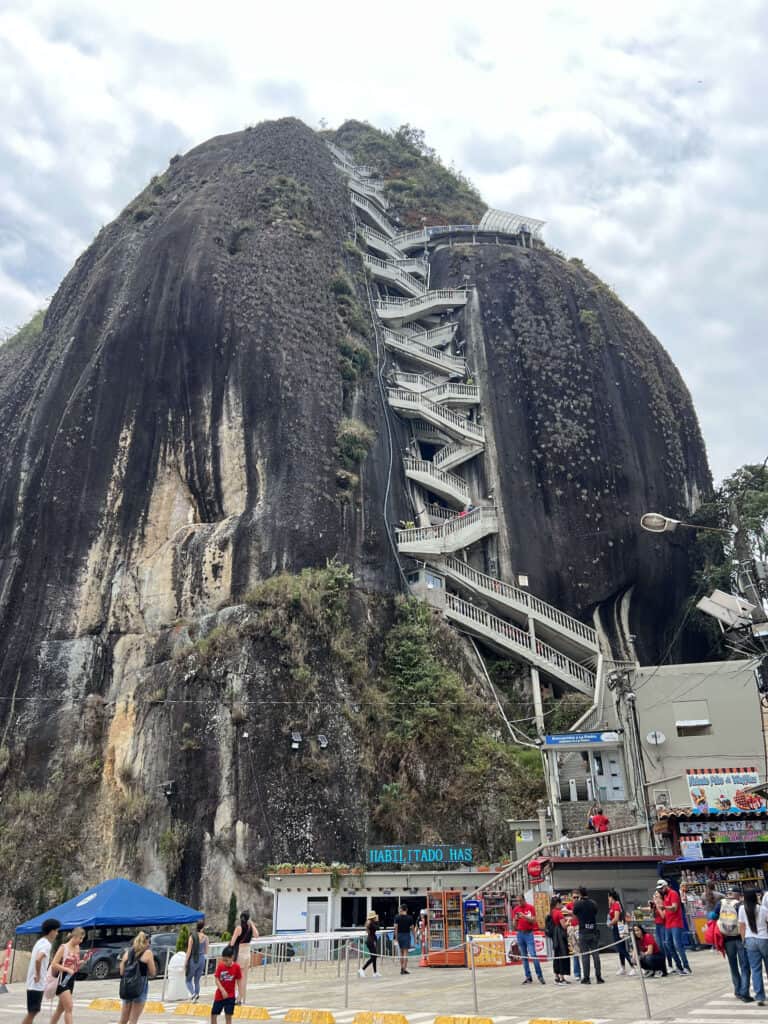

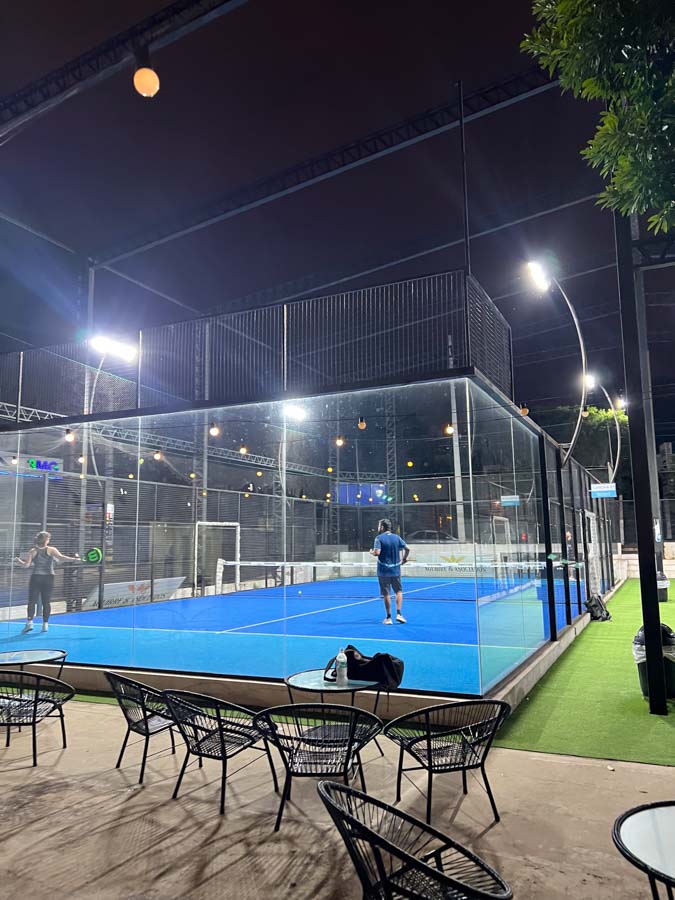
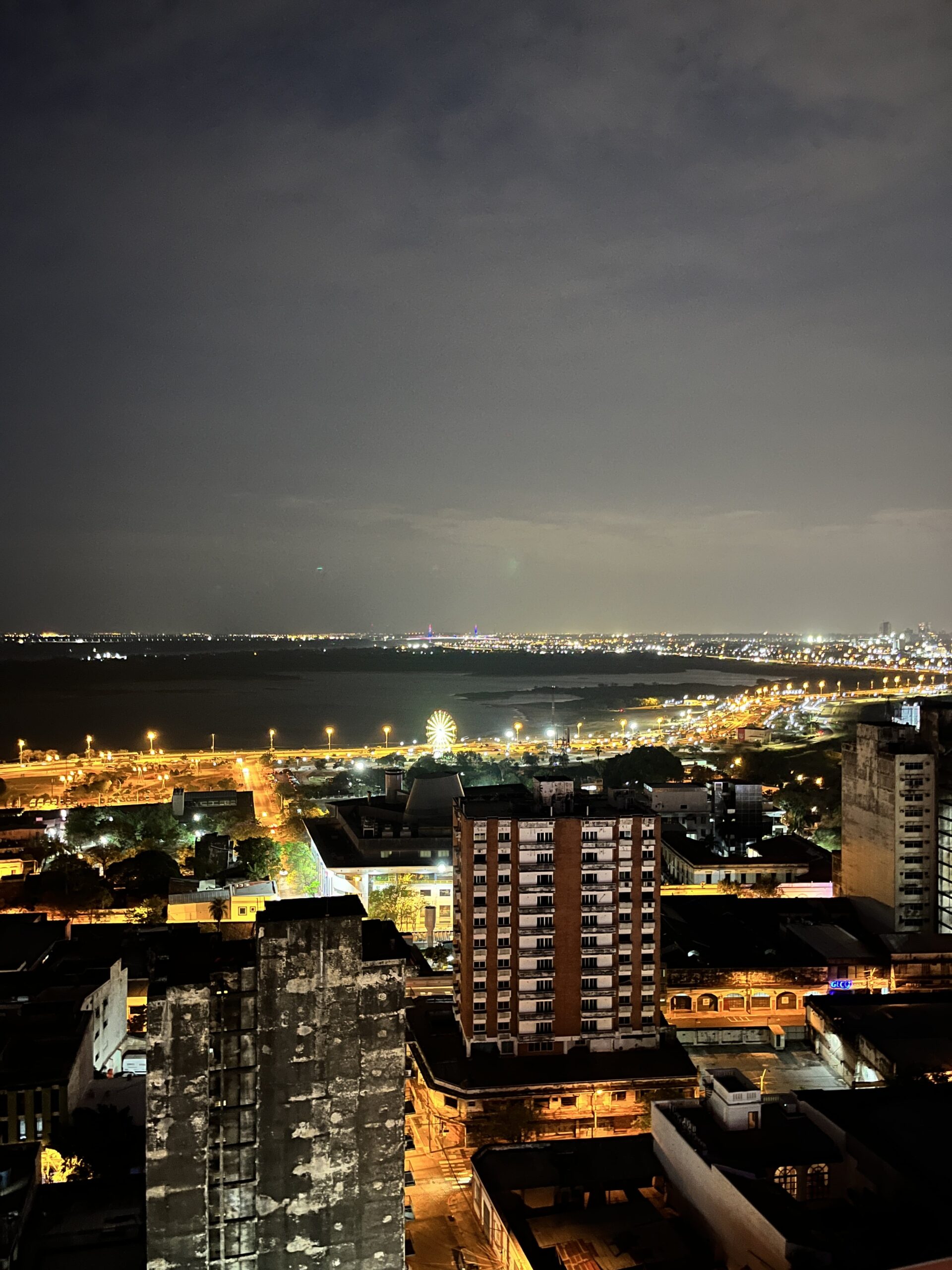
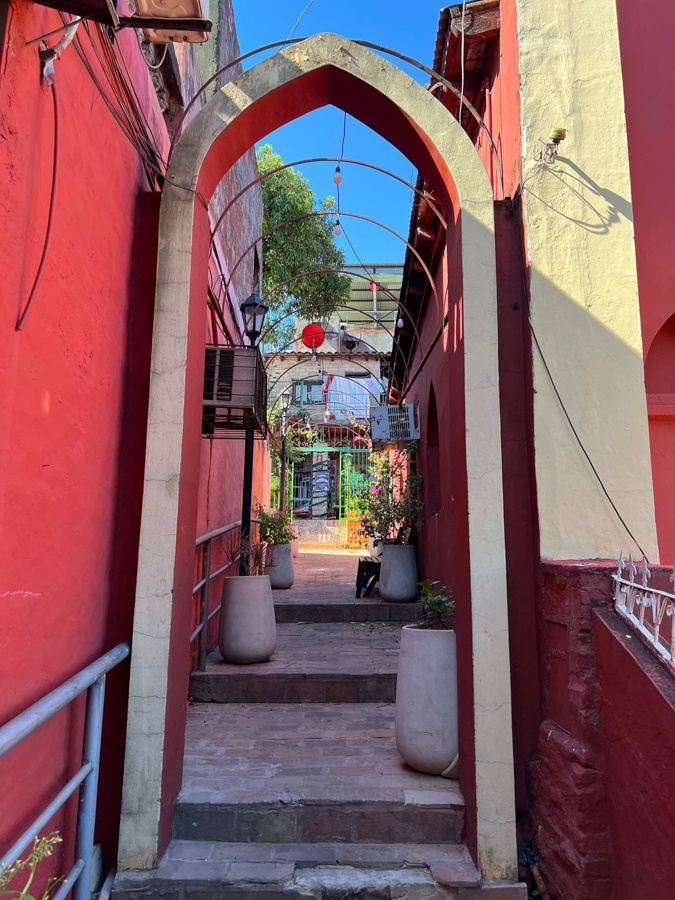
13 Comments